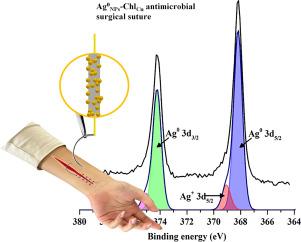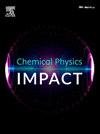Ultrasonic-driven synthesis of Cu-chlorophyllin-stabilized silver nanoparticles for high-efficiency antimicrobial surgical suture coatings
IF 4.3
Q2 CHEMISTRY, PHYSICAL
引用次数: 0
Abstract
A novel Cu-chlorophyllin-stabilized silver nanoparticle (Ag0NPs-ChlCu) with potent antimicrobial properties was synthesized for the first time using an ultrasonically driven chemical reduction approach. In this approach, Cu-chlorophyllin (ChlCu) acts as a stabilizing ligand, while sodium borohydride functions as the chemical reductant. The formation mechanism of Ag0-NPsCHL was elucidated, revealing that ultrasonic irradiation facilitates the in situ reduction of Ag (I) and its subsequent incorporation into the ChlCu complex. Four pyrrole rings coordinate with Ag0NPs through four nitrogen atoms, which serve as adsorption sites for the anchorage of Ag0-NPsCHL. Characterization by XPS revealed the presence of Ag-N bonding involving pyrrole units on the FCC structure of Ag0NPs. Ag0NPs-ChlCu demonstrated a zeta potential of (-) 35.57±3.54 mV with a spherical shape and an average size of 6.72±1.72 nm, resulting in a stable colloidal dispersion with a monodispersed index. The synthesized Ag0-NPsCHL nanocomposites were subsequently deposited onto polyamide surgical sutures via an electrostatic Layer-by-Layer (LbL) self-assembly technique. The coated sutures exhibited >99.9 % antibacterial efficiency against E. coli (ATCC25922), S. aureus (ATCC25923), and A. baumanii (ATCC19606). While nanoparticle accumulation was observed in human primary epidermal keratinocyte (HEKa) cells, no cytotoxic effects were detected in the epidermis. This study highlights the effectiveness of ChlCu as a dual stabilizing and coordinating agent for Ag⁰NPs, offering a promising approach for developing antimicrobial surgical materials.

超声驱动合成cu -叶绿素稳定纳米银用于高效抗菌外科缝合涂层
首次采用超声驱动化学还原法制备了一种新型的cu -叶绿素稳定银纳米粒子(Ag0NPs-ChlCu)。在这种方法中,叶绿素铜(ChlCu)作为稳定配体,而硼氢化钠作为化学还原剂。阐明了Ag0-NPsCHL的形成机制,揭示了超声照射有利于Ag (I)的原位还原并随后结合到ChlCu配合物中。4个吡咯环通过4个氮原子与Ag0NPs配位,作为Ag0-NPsCHL锚定的吸附位点。通过XPS表征发现Ag0NPs的FCC结构上存在涉及吡咯单元的Ag-N键。Ag0NPs-ChlCu的zeta电位为(-)35.57±3.54 mV,呈球形,平均粒径为6.72±1.72 nm,具有稳定的单分散指数。合成的Ag0-NPsCHL纳米复合材料随后通过静电逐层自组装技术沉积在聚酰胺手术缝合线上。包被缝线对大肠杆菌(ATCC25922)、金黄色葡萄球菌(ATCC25923)和鲍曼不动杆菌(ATCC19606)的抗菌效率为99.9%。虽然纳米颗粒在人原发性表皮角质形成细胞(HEKa)细胞中观察到积累,但在表皮中未检测到细胞毒性作用。这项研究强调了ChlCu作为Ag⁰NPs的双重稳定和协调剂的有效性,为开发抗菌外科材料提供了一种有前途的方法。
本文章由计算机程序翻译,如有差异,请以英文原文为准。
求助全文
约1分钟内获得全文
求助全文
来源期刊

Chemical Physics Impact
Materials Science-Materials Science (miscellaneous)
CiteScore
2.60
自引率
0.00%
发文量
65
审稿时长
46 days
 求助内容:
求助内容: 应助结果提醒方式:
应助结果提醒方式:


